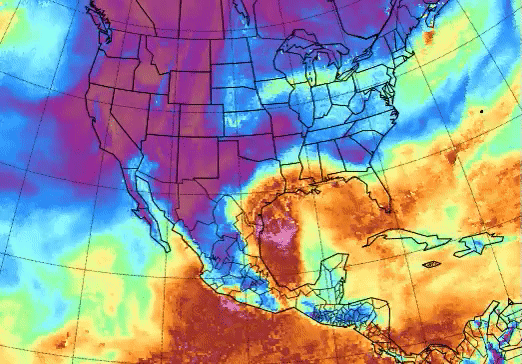Tropical Storm Nicholas batters Texas coast after making landfall as hurricane
The storm, fed with humidity from the tropics, is causing flash floods in Texas and Louisiana.

Tropical Storm Nicholas drenched Texas and parts of Louisiana Tuesday (Sept. 14), dumping more than 10 inches of rain within hours of making landfall on the Gulf Coast as a category 1 hurricane.
The National Oceanic and Atmospheric Administration (NOAA)'s National Hurricane Center has warned that the storm will bring heavy rain and trigger "life-threatening flash floods" across Texas and the neighboring Louisiana, which is still recovering from the rampage of Hurricane Ida only two weeks ago. Southern parts of Mississippi and Alabama will also be hit. After making landfall early Tuesday as a hurricane, Nicholas has since been downgraded to a tropical storm, center officials said.
The heavy rain is the most threatening aspect of Nicholas, according to meteorologists. The storm has soaked up large amounts of atmospheric moisture from the tropics, as can be seen in visualizations released by the University of Wisconsin-Madison's Cooperative Institute for Meteorological Satellite Studies.
Related: Hurricane Ida from space: Photos from astronauts and satellites
The hurricane made landfall near Houston, the home of NASA's Johnson Space Center, earlier today, but no information has been made available so far about the effects on the space agency's hub responsible for managing operations at the International Space Station.
Weather.com reported that the storm hit Texas with wind gusts of 95 mph (153 kph) pouring 11 inches (28 centimeters) of rain on the Houston metropolitan area within hours with more to come. In addition to the swelling creeks and rivers, storm surge submerged roads and land in the vicinity of the coast.
Power cuts affected at least half a million Texans and the state's Governor, Greg Abbott, declared a state of emergency for 17 counties, including the metropolitan Houston area.
Get the Space.com Newsletter
Breaking space news, the latest updates on rocket launches, skywatching events and more!

Nicholas will affect many areas along the Gulf Coast, including Louisiana's vibrant cultural hub New Orleans, NOAA predicted. The storm is now expected to move eastward and trail along the coast towards Louisiana, reaching New Orleans on Saturday (Sept. 18) as a tropical depression.
Nicholas is the sixth hurricane of the 2021 Atlantic season. Since satellite monitoring began, only nine years have recorded six and more hurricanes by mid-September, according to University of Wisconsin-Madison's meteorologist Philip Klotzbach.
Follow Tereza Pultarova on Twitter @TerezaPultarova. Follow us on Twitter @Spacedotcom and on Facebook.
Join our Space Forums to keep talking space on the latest missions, night sky and more! And if you have a news tip, correction or comment, let us know at: community@space.com.

Tereza is a London-based science and technology journalist, aspiring fiction writer and amateur gymnast. Originally from Prague, the Czech Republic, she spent the first seven years of her career working as a reporter, script-writer and presenter for various TV programmes of the Czech Public Service Television. She later took a career break to pursue further education and added a Master's in Science from the International Space University, France, to her Bachelor's in Journalism and Master's in Cultural Anthropology from Prague's Charles University. She worked as a reporter at the Engineering and Technology magazine, freelanced for a range of publications including Live Science, Space.com, Professional Engineering, Via Satellite and Space News and served as a maternity cover science editor at the European Space Agency.









